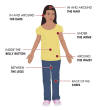Lyme Disease
Awareness, Prevention, and Care
Prevention & Treatment
Prevention Tips
The best defense against Lyme disease is prevention. Simple steps like wearing long sleeves, tucking pants into socks, and applying insect repellents containing DEET or permethrin can significantly reduce the risk. For pet owners, tick collars and regular grooming can help prevent ticks from entering the home.
Daily Tick Checks
Checking your body for ticks after outdoor activities and showering within two hours can greatly lower infection chances (CDC, 2023c). These quick habits can stop ticks from attaching long enough to transmit the bacteria.
Post Treatment Considerations
Some individuals continue to experience fatigue, pain, or cognitive issues even after treatment — a condition known as Post-Treatment Lyme Disease Syndrome (PTLDS). Current guidelines recommend managing symptoms rather than giving additional antibiotics (CDC, 2023c). The causes of PTLDS remain unclear, and research is ongoing.


